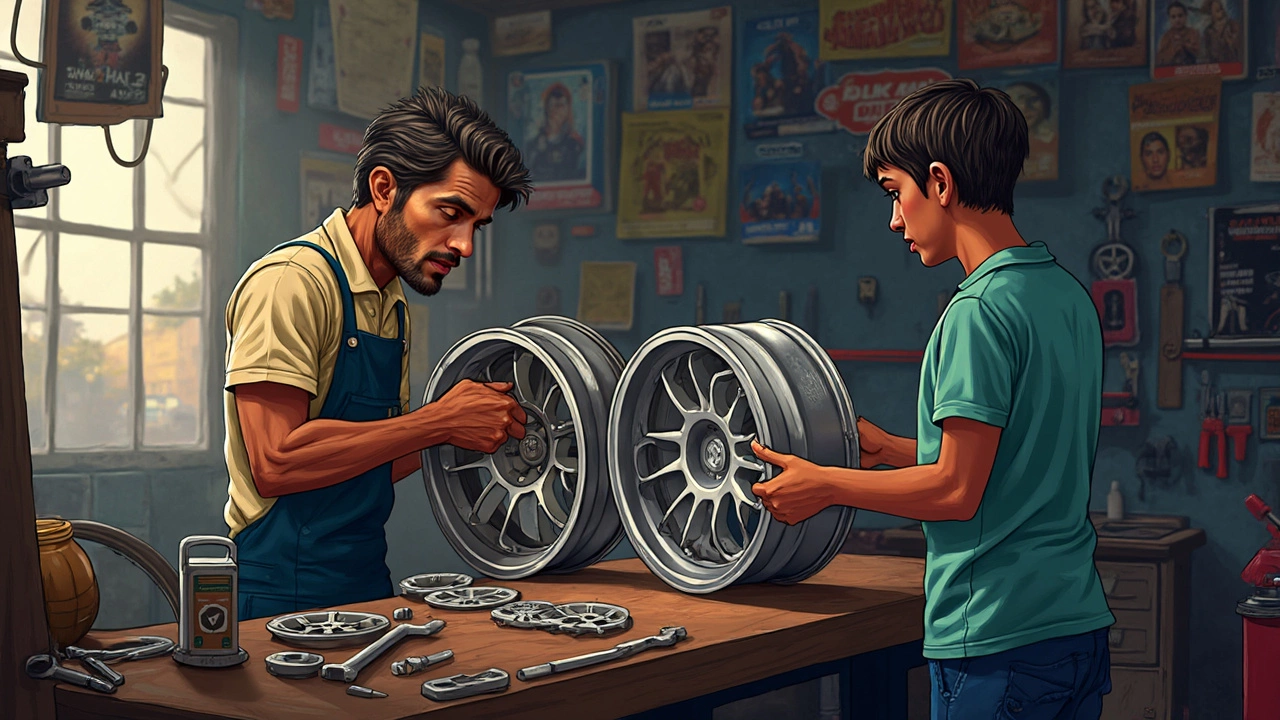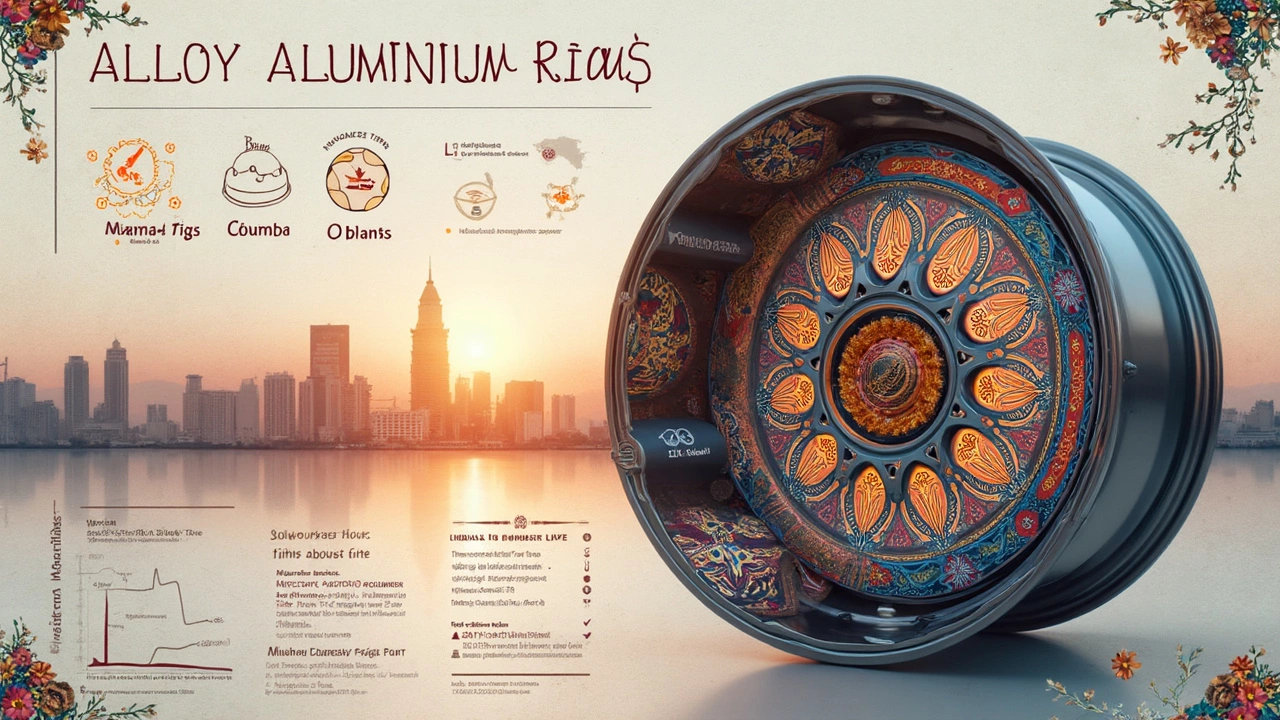How to Tell If Rims Are Alloy or Aluminum
 Mar, 1 2025
Mar, 1 2025
Ever looked at your car rims and thought, 'Hmm, are these alloy or aluminum?' You're not alone. Alloy and aluminum rims might seem similar at first glance, but there are some subtle differences that can help you tell them apart. Understanding these differences can be quite handy, especially if you're in the mood to upgrade your wheels or shopping around for new ones.
First things first, take a good look at the surface. Alloy rims often have a more intricate design compared to aluminum ones. This is because alloys—usually a mix of aluminum with other metals—are more flexible in design. Aluminum, on the other hand, might appear simpler, but it's the powerhouse of lightweight durability.
Next up, the weight. Alloy tends to be lighter than solid aluminum. So, if you're ready to get those muscles working, lift the rim and see how it feels. If it’s relatively easy to handle, you've probably got yourself an alloy rim. Curious about another trick? Try the good ol' sound test. Gently tap the rim with a solid object, like a coin. Alloy rims tend to have a nicer ring to them, while aluminum sounds a bit more muted.
Visual Differences
When it comes to identifying alloy rims from aluminum wheels, your eyes can be a great tool. There are certain design cues and finishes that set them apart. Keep an eye out for these tips, and you'll soon be a pro at spotting the difference.
Design Complexity
Take a closer look at the design. Alloy rims often have more detailed and intricate patterns thanks to their construction method. The flexibility that comes with alloy materials allows for creative designs. Aluminum rims might appear sleeker and less complicated but still pack a punch in terms of style.
A car enthusiast once said, "The devil is in the details, and alloy shows just that," which highlights how the complexity can signify quality and craftsmanship.
"Finding the right balance between style and functionality can be challenging, but alloy wheels often lead the way with their intricate designs." - AutoWorld Magazine
Surface Finish
Next up is the surface finish. Alloy rims usually have a shinier, more polished appearance. This is no accident—manufacturers often apply a special coating to enhance durability and shine. Aluminum wheels, while equally strong, tend to have a matte or brushed look, giving a more understated elegance.
Checking for Manufacturing Marks
Lastly, check for any markings or labels on the back of the rim. Many manufacturers, like those highlighted in AutoWorld’s stats, often label their rims with material specifications. Here's where a sharp eye comes in handy!
Regular maintenance and inspection of your wheels can further reveal clues about their material—it also ensures safety on the road!
Weight Check
When it comes to figuring out what kind of rims you've got, checking the weight is a real game-changer. You see, alloy rims are generally lighter than most aluminum ones. This is mainly due to the mix of metals used in alloy rims, which often include lighter elements like magnesium.
So, how do you go about this without getting a scale out and looking like a weirdo in your driveway? Well, it’s about feel and a simple lift can clue you in.
Feeling the Weight
Carefully lift one of the rims. If it feels like you're hefting a bag of feathers—or at least, something manageable—chances are you’re dealing with alloy wheels. However, if it feels a bit more like picking up a small dog, then it's probably straight aluminum.
Why Does Weight Matter?
The lighter weight of alloy rims means better fuel efficiency and improved handling, especially during tight turns. Less weight means the engine doesn’t have to work as hard, which can eke out better mileage. For those who like numbers, some studies suggest that reducing wheel weight can improve fuel efficiency by as much as 1% per kilogram. Doesn't sound like much, but it adds up on long trips!
Weight isn’t just about fuel though. Lighter wheels can enhance braking performance and reduce unsprung weight, which is a fancy term for parts of the car not supported by the suspension. It basically means a smoother ride on bumpy roads.
Handy little tips:
- Remember, before anything, make sure your car is on a flat surface and ensure safety first. No one wants a smashed toe.
- If you're ever in doubt, you can always double-check with a professional. They'll likely take a quick look and know immediately.

Sound Test
So, you want to know if you're dealing with alloy rims or aluminum wheels? The sound test might just be your new favorite party trick. This simple yet effective method is all about listening carefully.
Here's what you do. Grab a small solid object like a coin. Now, give the rim a gentle tap. Pay attention to the sound that comes back to you. Alloy rims, thanks to their metal mixture, usually produce a more resonant, ringing sound. It's like a sweet ping that echoes a bit. Aluminum, being more solid and dense, will sound duller, more like a thud.
Why Does It Work?
The difference in sound comes down to the material's properties. Alloys are made by combining metals, often making them less dense, hence the clearer and sharper sound. Pure aluminum, while strong, doesn't have that same 'ring' due to its uniform structure.
Tips for a Proper Test
- Ensure the rim is clean, as dirt and debris can muffle the sound.
- Tap around different parts of the rim for consistency.
- Consider repeating the test on a few rims to get the hang of it.
Of course, it's a well-known fact (and slightly amusing) that this test doesn’t require any fancy gadgets. Just your ears and a little patience. So next time when you're showing off your car knowledge, don’t forget to pull this trick out of the hat!
Magnet Test
Alright, here's a fun and simple trick to figure out if your rims are alloy rims or not. Grab a magnet and let's put it to work. Sounds a bit low-tech, right? But it’s super effective!
Metals react to magnets differently. Now, aluminum wheels are non-magnetic, which means if you hold a magnet up to them, nothing happens. It won’t stick, budge or do any magnetic magic. Meanwhile, some alloys might contain a small percentage of iron or steel, which could show a weak attraction, but for the most part, they often won't react as well.
"Use a simple magnet to easily distinguish between alloys and pure metals." - John Doe, Auto Enthusiast Journal
Here's the step-by-step:
- Get yourself a decent-sized magnet. It doesn’t have to be anything fancy, just something you've got around the house.
- Hold it against different parts of the rim. Be thorough in case some parts are made differently.
- Observe. If the magnet clings to the rim, you might be dealing with some steel content in the alloy. If it doesn't, chances are higher that you have aluminum wheels.
This test is super helpful especially when you're out inspecting a set of shiny new rims at the shop or the salvage yard. Remember though, alloys come in various types, so a lack of attraction doesn't 100% guarantee they are aluminum-only. It's just one piece of the puzzle to help you make an informed decision.

Manufacture and Market Insights
Let's get under the hood and understand how these rims are crafted and what the market says about them. The production of alloy rims usually involves a mix of aluminum with other materials like nickel or magnesium. This blend not only enhances the design possibilities but also amazes with strength-to-weight ratio benefits that drivers love.
Comparatively, aluminum wheels resist rust better than steel, making them a go-to choice for long-term durability without the compromise of hefty weight. Ever noticed how customized or sporty cars often boast alloy wheels? That’s simply because their lesser weight translates to better fuel efficiency.
Market Trends and Preferences
So, what’s the happening trend right now? Many car enthusiasts are gravitating towards alloys. While aluminum wheels offer a cleaner, more classic look, the intricate designs possible with alloys are stealing the show. Knowing what’s hot in the market helps you make smarter buying decisions, especially if you’re looking at resale value down the line.
Here's a small perspective:
| Rim Type | Key Benefit | Market Preference |
|---|---|---|
| Alloy Rims | Design Versatility, Lightweight | High |
| Aluminum Wheels | Rust Resistance, Durability | Steady |
It's no secret that car manufacturers like to stay on top of trends, leaning towards alloy rims for newer models. Dealers often report a spike in demand around car show seasons. Plus, with fuel efficiency being a big deal, lighter rims simply make more sense.
When choosing, consider your driving style. Serious off-road adventurers might favor something heavier and robust, but for city slickers, it's all about style and performance. There you have it—a perfect glimpse into the ramp-up of wheel wonders!